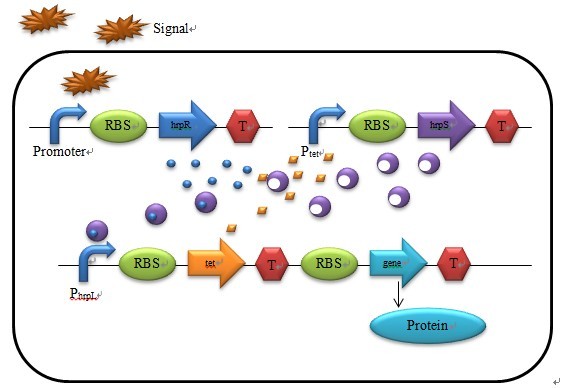Team:HIT-Harbin
From 2013.igem.org
(Difference between revisions)
| Line 1: | Line 1: | ||
<!-- *** What falls between these lines is the Alert Box! You can remove it from your pages once you have read and understood the alert *** --> | <!-- *** What falls between these lines is the Alert Box! You can remove it from your pages once you have read and understood the alert *** --> | ||
| + | |||
| + | <!--- The Mission, Experiments ---> | ||
| + | |||
| + | {| style="color:#1b2c8a;background-color:#0c6;" cellpadding="3" cellspacing="1" border="1" bordercolor="#fff" width="62%" align="center" | ||
| + | !align="center"|[[Team:HIT-Harbin|Home]] | ||
| + | !align="center"|[[Team:HIT-Harbin/Team|Team]] | ||
| + | !align="center"|[https://igem.org/Team.cgi?year=2013&team_name=HIT-Harbin Official Team Profile] | ||
| + | !align="center"|[[Team:HIT-Harbin/Project|Project]] | ||
| + | !align="center"|[[Team:HIT-Harbin/Parts|Parts Submitted to the Registry]] | ||
| + | !align="center"|[[Team:HIT-Harbin/Modeling|Modeling]] | ||
| + | !align="center"|[[Team:HIT-Harbin/Notebook|Notebook]] | ||
| + | !align="center"|[[Team:HIT-Harbin/Safety|Safety]] | ||
| + | !align="center"|[[Team:HIT-Harbin/Attributions|Attributions]] | ||
| + | |} | ||
{|align="central" | {|align="central" | ||
| Line 12: | Line 26: | ||
<div id="box" style="width: 700px; margin-left: 137px; padding: 5px; border: 3px solid #000; "> | <div id="box" style="width: 700px; margin-left: 137px; padding: 5px; border: 3px solid #000; "> | ||
<div id="template" style="text-align: center; font-weight: bold; font-size: large; color: #006600; padding: 5px;"> | <div id="template" style="text-align: center; font-weight: bold; font-size: large; color: #006600; padding: 5px;"> | ||
| - | PROJECT DESCRIPTION. | + | PROJECT DESCRIPTION.<p></p> |
| + | Biological Proportional Operational MU-circuit | ||
</div> | </div> | ||
<div id="instructions" style="text-align: central; font-weight: normal; font-size: small; color: #006600; padding: 5px;"> | <div id="instructions" style="text-align: central; font-weight: normal; font-size: small; color: #006600; padding: 5px;"> | ||
| Line 25: | Line 40: | ||
<!-- *** End of the alert box *** --> | <!-- *** End of the alert box *** --> | ||
| - | |||
| - | |||
| - | |||
| - | |||
| - | |||
| - | |||
| - | |||
| - | |||
| - | |||
| - | |||
| - | |||
| - | |||
| - | |||
| - | |||
| - | |||
| - | |||
Revision as of 05:38, 7 August 2013
| Home | Team | Official Team Profile | Project | Parts Submitted to the Registry | Modeling | Notebook | Safety | Attributions |
|---|
PROJECT DESCRIPTION.
Biological Proportional Operational MU-circuit
In 1990s, Eric Mjolsness and several researchers developed the concept of genetic circuit from electronic circuits, to facilitate research in modeling gene expression and regulation (Mjolsness, Sharp et al. 1991, McAdams and Shapiro 1995, Reinitz and Sharp 1996, Sharp and Reinitz 1998). Upon the inspiration, Ron Weiss, a computer engineer of MIT, constructed an AND-gate genetic circuit in 2001 (Weiss, Knight et al. 2001). Based on Weiss’ pioneering result, the team of Jeff Hasty took IPTG (isopropyl β-D-1-Thiogalactopyranoside) and aTc (anhydrotetracycline) as the inputs and GFP (green fluorescent protein) as the output; demonstrating the AND-gate circuit in a more lucid and applicable way (Hasty, McMillen et al. 2002). In 2005, to investigate the prospect of genetic circuit, Oliver Rackham proved that other kinds of logic circuits are feasible by orthogonal topological structures (Rackham and Chin 2005). In 2013 iGEM, we inherit the idea of resembling electronic circuits. By incorporating AND/OR gate and operational amplifier into one circuit, we create our device-Biological Proportional Operational Mu-circuit (B-POM).
In comparison with Weiss’ invention, B-POM has only one homogeneous or heterogeneous input and output. Besides, multiple magnitudes of input are distinguishable by the new circuit, and a given input corresponds to a certain output. Moreover, whereas general genetic circuits are vulnerable to the noise of cellular background, B-POM seems more interference-free, implicating the prominent stability of our device.
In applications, we plan to enhance Bio-electric Interface, the device designed by 2012 Edinburg iGEM team. If the input is biochemical signal molecules and the output become electrons, B-POM can be coupled with Bio-electric Interface, that ephemeral processes in cells will be precisely measurable by simple electronic methods and analyzable by computer. B-POM is also helpful in yoghurt producing, where the control of pH is inaccurate. When B-POM is transplanted into yoghurt-producing bacteria, let hydrogen ions be the input and lacR be the output, and select the proper B-POM parameters, then the pH will be steady around 5.5. In short, our inspired and reliable device is promising in various fields.
 "
"
